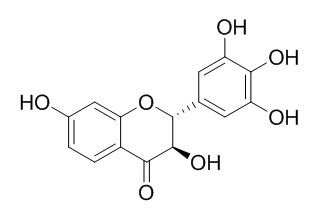Dihydrorobinetin
(+)-Dihydrorobinetin is reported as a chemical marker of vinegars aged in acacia wood and can be used for authenticity purposes.
Inquire / Order:
manager@chemfaces.com
Technical Inquiries:
service@chemfaces.com
Tel:
+86-27-84237783
Fax:
+86-27-84254680
Address:
1 Building, No. 83, CheCheng Rd., Wuhan Economic and Technological Development Zone, Wuhan, Hubei 430056, PRC
Providing storage is as stated on the product vial and the vial is kept tightly sealed, the product can be stored for up to
24 months(2-8C).
Wherever possible, you should prepare and use solutions on the same day. However, if you need to make up stock solutions in advance, we recommend that you store the solution as aliquots in tightly sealed vials at -20C. Generally, these will be useable for up to two weeks. Before use, and prior to opening the vial we recommend that you allow your product to equilibrate to room temperature for at least 1 hour.
Need more advice on solubility, usage and handling? Please email to: service@chemfaces.com
The packaging of the product may have turned upside down during transportation, resulting in the natural compounds adhering to the neck or cap of the vial. take the vial out of its packaging and gently shake to let the compounds fall to the bottom of the vial. for liquid products, centrifuge at 200-500 RPM to gather the liquid at the bottom of the vial. try to avoid loss or contamination during handling.
Journal of Functional Foods2022, 96: 105216.
Biomed Pharmacother.2024, 181:117647.
Drug Des Devel Ther.2023, 17:2461-2479.
Int J Mol Sci.2023, 24(14):11496.
Appl. Sci.2020, 10(16),5482.
J Cell Mol Med.2024, 28(16):e70016.
National Natural Science Foundation of China2024, pages 33.
Pharmaceutics.2021, 13(7):1028.
Sci Rep.2017, 7:467-479
Planta Med.2022, a-1876-3009.
Related and Featured Products
J Agric Food Chem. 2009 Oct 28;57(20):9551-4.
(+)-Dihydrorobinetin: a marker of vinegar aging in acacia (Robinia pseudoacacia) wood.[Pubmed:
19785439]
(+)-Dihydrorobinetin, a dihydroflavonol identified for the first time in vinegars as a marker of aging in this kind of wood.
METHODS AND RESULTS:
This study also reports for the first time the complete assignment of (13)C NMR data for this compound. Moreover, it revealed a longer contact time with acacia wood results in higher concentrations of (+)-Dihydrorobinetin found in vinegars. Another finding was that the vinegars aged with nontoasted acacia chips showed significantly higher concentrations of (+)-Dihydrorobinetin than found in vinegars aged with toasted acacia chips (384.8 and 23.5 mg/L, respectively). The in vitro antioxidant activity (DPPH(*) and ORAC assays) of (+)-Dihydrorobinetin was also determined.
CONCLUSIONS:
(+)-Dihydrorobinetin is reported here for the first time as a chemical marker of vinegars aged in acacia wood and can be used for authenticity purposes.



